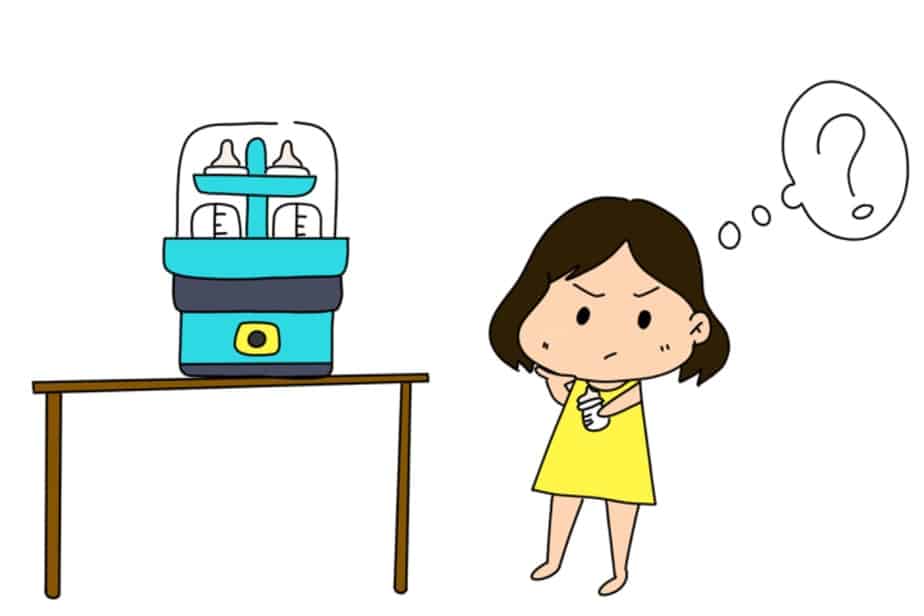In the beginning, we used to sterilize our baby bottles and breast pump equipment after every use without a second thought. Eventually, we begin to wonder, do we really need to sterilize the bottles after each use?
So, how often should I sterilize baby bottles? You must sterilize the baby bottle before the first use, this includes bottles passed down to you by someone else. In countries where you cannot drink straight from the tap, you must sterilize the bottles after every use until your baby is at least 6 months to a year old.
The CDC FAQ also recommends we sterilize after each use if our baby is younger than 3 months old [source] Still, is it really necessary to sterilize the bottles after every use? Doesn’t it seem excessive? Let’s find out.
Why Sterilize Bottles So Often?
Sterilizing the bottle kills harmful germs that can harm your baby, this is especially important in the first 3 months when your baby’s immune system is weak. Babies below 3 months of age cannot fight off viruses as well as 3-month-olds, so it’s recommended to do everything you can to keep your baby healthy, sterilizing bottles after each use is one of them.
While cleaning the bottles with soap is still required, it will not be as thorough as sterilizing the bottles. Any spots you missed, especially those really tiny gaps and spaces, can be a breeding ground for germs.
Sterilization is typically very thorough; whether you dunk it in boiling water, put it through an electric steamer, microwave or UV sterilizer, it will cover all gaps and spaces and kill germs hiding there. Just to be clear, you must wash the bottle with detergents first before sterilizing.
When Can I Reduce Sterilizing Bottles?
In the beginning, you should sterilize the bottles after every use, but when your baby is 3 months old, his immune system is built up and you may reduce sterilization to once a day if you live in an area with drinkable tap water.
Clean water is subjective and can be difficult to define; hence I’m benchmarking it against drinkable tap water. In my country, the tap water is clean but not drinkable, and because of that, we continued to sterilize our baby’s bottle until he was 1 year old.
If you don’t have access to drinkable tap water, it’s better to wash and sterilize after every use until your baby is a year old because we cannot tell what is in the water. It can contain dirt, rust particles, sediment, and so on. This is especially true in some places in the world where there is a lack of clean water.
A lack of clean water is a leading cause of child mortality where diarrhea is estimated to cause 1.5 million child deaths per year, mostly among children under 5 living in developing countries. If you’re traveling to a place without clean water, check the Related Questions section to see how you can keep bottles sterilized while traveling.
Is It Mandatory To Sterilize Bottles?
No, it is not absolutely necessary. I know of some parents who have never sterilized the bottles and have healthy babies. All we’re doing is to reduce the risk of our baby getting sick, and this is one of the practical ways to reduce that risk.
The equipment needed to sterilize the bottles can be expensive though, and if the cost is the reason you’re hesitating, I have good news for you! The cheapest way, and yet still equally effective method is to sterilize the bottles using boiling water. All you need is a pot, a thong, and a stove!
Yes, this method requires your constant attention, you can’t just leave it there and walk away like the other methods, but it is very affordable and effective. My sister made a short video here to demonstrate how to do it, check it out.
What is the best way to sterilize the bottles?
I find that the best way is to use a UV sterilizer. We tend to be careful when sterilizing bottle teats at high temperatures, and although teats made by many brands can withstand high temperatures, it’s better not to push them. UV sterilizers do not operate at high temperatures; hence they will maintain the longevity of the items being sterilized. There’s a nice bonus for using UV sterilizers, and you can easily sterilize all kinds of things such as your toddler’s toys too! Here’s a link to Amazon if you’re looking for one.
Before you begin sterilizing, make sure you wash the items with water and soap or detergent first. You do not need to use specially made detergent for baby bottles, bowls, or utensils, I feel that it’s just a marketing gimmick to drive demand. I use normal dish detergent, and it just works fine!
If you have baby drinking cups that have many parts, make sure they are properly dismantled and washed before putting them into the sterilizer. Check with the bottle manual or manufacturer on which parts can be sterilized at high temperatures as not all parts can take the high heat.
Again, if you’re using the UV sterilizer, you don’t have to worry whether the parts can withstand high temperatures or not! Just so good! Here are some pros and cons of some of the available methods.
UV Sterilizer
Pros: Very easy to use, just place it and leave, you can come back later to collect. It does not use high temperatures and is suitable for all parts. It can be used to sterilized toys too.
Cons: Takes up table space, expensive.
Steam Sterilizer
Pros: Easy to use, just place it and leave, you can come back later to collect.
Cons: Very hot! Some parts may not be suitable due to the high temperature. Steam needs an exit too which can cause damage to nearby items so you need to place them strategically.
Boiling Water
Pros: Does not need specialized equipment, cheapest method, and is yet equally effective.
Cons: Very hot! Some parts may not be suitable due to the high temperature. Be careful not to burn yourself.
Microwave
Pros: If you already have it, you don’t need to buy any other equipment. Easier than boiling water.
Cons: Have to clean the microwave thoroughly before use, which can be a hassle if you use it often for heating up food. If you’re not careful, you may melt the bottles or teats.
Related Questions
How to Keep Bottles Sterilized while Travelling? We’ve been emphasizing the importance of sterilizing the bottles frequently. Still, during travels, we also want to keep the things we bring to a minimum, there is no room to bring our sterilizing equipment with us!
For this, I find that the best way is to use drop-in bottle liners, here’s a link to Amazon if you need to get one. These things keep cleaning down to a minimum, and since the milk is stored in the pre-sterilized bottle liner, it makes it safe to drink. It is meant to be disposable, so do not re-use it.
The liners can be bought separately in different quantities and ounces, pick the right one for your needs. Unfortunately, this method doesn’t cover sterilizing the teats. I’ll recommend you sterilize the teats using boiling water as it will save you a lot of luggage space. Plan in advance to make sure the place you’re staying has facilities to boil water.
Do I need to sterilize the breast pump equipment too? Yes! Breast pump equipment should be washed and sterilized after every use. Even a little breast milk left on the equipment will turn it into a breeding ground for germs.
Take note that not all parts can be sterilized at high temperatures, check the manual or the manufacturer before sterilizing. Not all parts need to be sterilized, only the parts that come into contact with the milk such as the bottles, valves, tubes, and breast shields. We even sterilize all utensils and bowls our baby use for the first 6 months.
What other things should I sterilize? It’s recommended that once in a while, we sterilize things that our baby tends to put into their mouths, such as teething toys, or any other toys that they like to bite. Often times we neglect these things and yet our baby spends a lot of time biting them!
Again, the easiest method would be to use a UV sterilizer because it doesn’t use water or heat, so you don’t have to worry about damage. If you’re using other types of sterilizers, you may be limited in what you can sterilize. If you have no choice though, don’t fret over it. By this time, your baby should already be over 3 months old, and his immune system is likely a lot stronger.
Don’t be too overly concerned about sterilizing everything and let it stress you up, just do your best and that will be enough. Though this may seem counter to the whole article, our kids do need some level of exposure to bacteria, that aids in their immune system growth. We basically stopped sterilizing everything when our boy grew to one year old, and he is as healthy as ever.

